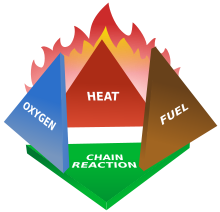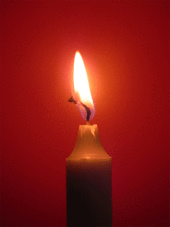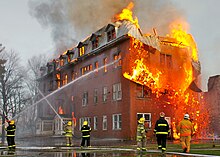Fire
This article needs additional citations for verification. (April 2023) |

Fire is the rapid
Fire, in its most common form, has the potential to result in
Fire is one of the four classical elements and has been used by humans in rituals, in agriculture for clearing land, for cooking, generating heat and light, for signaling, propulsion purposes, smelting, forging, incineration of waste, cremation, and as a weapon or mode of destruction.
Etymology
The word "fire" originated from
History
Fossil record
The fossil record of fire first appears with the establishment of a land-based flora in the
Human control of fire
Early human control

The ability to control fire was a dramatic change in the habits of early humans.
Fire has also been used for centuries as a method of torture and execution, as evidenced by death by burning as well as torture devices such as the iron boot, which could be filled with water, oil, or even lead and then heated over an open fire to the agony of the wearer.
By the Neolithic Revolution, during the introduction of grain-based agriculture, people all over the world used fire as a tool in landscape management. These fires were typically controlled burns or "cool fires", as opposed to uncontrolled "hot fires", which damage the soil. Hot fires destroy plants and animals, and endanger communities.[21] This is especially a problem in the forests of today where traditional burning is prevented in order to encourage the growth of timber crops. Cool fires are generally conducted in the spring and autumn. They clear undergrowth, burning up biomass that could trigger a hot fire should it get too dense. They provide a greater variety of environments, which encourages game and plant diversity. For humans, they make dense, impassable forests traversable. Another human use for fire in regards to landscape management is its use to clear land for agriculture. Slash-and-burn agriculture is still common across much of tropical Africa, Asia and South America. For small farmers, controlled fires are a convenient way to clear overgrown areas and release nutrients from standing vegetation back into the soil.[22] However, this useful strategy is also problematic. Growing population, fragmentation of forests and warming climate are making the earth's surface more prone to ever-larger escaped fires. These harm ecosystems and human infrastructure, cause health problems, and send up spirals of carbon and soot that may encourage even more warming of the atmosphere – and thus feed back into more fires. Globally today, as much as 5 million square kilometres – an area more than half the size of the United States – burns in a given year.[22]
Later human control
There are numerous modern applications of fire. In its broadest sense, fire is used by nearly every human being on Earth in a controlled setting every day. Users of
Use of fire in war
The use of fire in warfare has a long history. Fire was the basis of all early thermal weapons. The Byzantine fleet used Greek fire to attack ships and men.
The invention of gunpowder in China led to the fire lance, a flame-thrower weapon dating to around 1000 CE which was a precursor to projectile weapons driven by burning gunpowder.
The earliest modern flamethrowers were used by infantry in the First World War, first used by German troops against entrenched French troops near Verdun in February 1915.[24] They were later successfully mounted on armoured vehicles in the Second World War.
Hand-thrown
Incendiary bombs were dropped by
Fire management
Controlling a fire to optimize its size, shape, and intensity is generally called fire management, and the more advanced forms of it, as traditionally (and sometimes still) practiced by skilled cooks, blacksmiths, ironmasters, and others, are highly skilled activities. They include knowledge of which fuel to burn; how to arrange the fuel; how to stoke the fire both in early phases and in maintenance phases; how to modulate the heat, flame, and smoke as suited to the desired application; how best to bank a fire to be revived later; how to choose, design, or modify stoves, fireplaces, bakery ovens, industrial furnaces; and so on. Detailed expositions of fire management are available in various books about blacksmithing, about skilled camping or military scouting, and about domestic arts.
Productive use for energy
Burning fuel converts chemical energy into heat energy; wood has been used as fuel since prehistory.[27] The International Energy Agency states that nearly 80% of the world's power has consistently come from fossil fuels such as petroleum, natural gas, and coal in the past decades.[28] The fire in a power station is used to heat water, creating steam that drives turbines. The turbines then spin an electric generator to produce electricity.[29] Fire is also used to provide mechanical work directly by thermal expansion, in both external and internal combustion engines.
The unburnable solid remains of a combustible material left after a fire is called clinker if its melting point is below the flame temperature, so that it fuses and then solidifies as it cools, and ash if its melting point is above the flame temperature.
Physical properties
Chemistry

Fire is a chemical process in which a
Fires start when a
Once ignited, a chain reaction must take place whereby fires can sustain their own heat by the further release of heat energy in the process of combustion and may propagate, provided there is a continuous supply of an oxidizer and fuel.
If the oxidizer is oxygen from the surrounding air, the presence of a force of gravity, or of some similar force caused by acceleration, is necessary to produce convection, which removes combustion products and brings a supply of oxygen to the fire. Without gravity, a fire rapidly surrounds itself with its own combustion products and non-oxidizing gases from the air, which exclude oxygen and extinguish the fire. Because of this, the risk of fire in a spacecraft is small when it is coasting in inertial flight.[32][33] This does not apply if oxygen is supplied to the fire by some process other than thermal convection.

Fire can be extinguished by removing any one of the elements of the fire tetrahedron. Consider a natural gas flame, such as from a stove-top burner. The fire can be extinguished by any of the following:
- turning off the gas supply, which removes the fuel source;
- covering the flame completely, which smothers the flame as the combustion both uses the available oxidizer (the oxygen in the air) and displaces it from the area around the flame with CO2;
- application of an inert gas such as carbon dioxide, smothering the flame by displacing the available oxidizer;
- application of water, which removes heat from the fire faster than the fire can produce it (similarly, blowing hard on a flame will displace the heat of the currently burning gas from its fuel source, to the same end); or
- application of a retardant chemical such as Halon (largely banned in some countries as of 2023[update]) to the flame, which retards the chemical reaction itself until the rate of combustion is too slow to maintain the chain reaction.
In contrast, fire is intensified by increasing the overall rate of combustion. Methods to do this include balancing the input of fuel and oxidizer to stoichiometric proportions, increasing fuel and oxidizer input in this balanced mix, increasing the ambient temperature so the fire's own heat is better able to sustain combustion, or providing a catalyst, a non-reactant medium in which the fuel and oxidizer can more readily react.
Flame

A flame is a mixture of reacting gases and solids emitting visible,

The glow of a flame is complex.

The common distribution of a flame under normal gravity conditions depends on
Typical adiabatic temperatures
The adiabatic flame temperature of a given fuel and oxidizer pair is that at which the gases achieve stable combustion.
- Oxy–dicyanoacetylene 4,990 °C (9,000 °F)
- Oxy–acetylene 3,480 °C (6,300 °F)
- Oxyhydrogen 2,800 °C (5,100 °F)
- Air–acetylene2,534 °C (4,600 °F)
- Blowtorch (air–MAPP gas) 2,200 °C (4,000 °F)
- Bunsen burner (air–natural gas) 1,300 to 1,600 °C (2,400 to 2,900 °F)[37]
- Candle (air–paraffin) 1,000 °C (1,800 °F).
Fire science
Fire science is a branch of
Fire ecology
Every natural ecosystem on land has its own fire regime, and the organisms in those ecosystems are adapted to or dependent upon that fire regime. Fire creates a mosaic of different habitat patches, each at a different stage of succession.[38] Different species of plants, animals, and microbes specialize in exploiting a particular stage, and by creating these different types of patches, fire allows a greater number of species to exist within a landscape.
Prevention and protection systems

Wildfire prevention programs around the world may employ techniques such as wildland fire use and prescribed or controlled burns.[39][40] Wildland fire use refers to any fire of natural causes that is monitored but allowed to burn. Controlled burns are fires ignited by government agencies under less dangerous weather conditions.[41]
Fire prevention is intended to reduce sources of ignition. Fire prevention also includes education to teach people how to avoid causing fires.[42] Buildings, especially schools and tall buildings, often conduct fire drills to inform and prepare citizens on how to react to a building fire. Purposely starting destructive fires constitutes arson and is a crime in most jurisdictions.[43]
Model
Where fire prevention and fire protection have failed to prevent damage,
See also
- Aodh (given name)
- Bonfire
- The Chemical History of a Candle
- Colored fire
- Control of fire by early humans
- Deflagration
- Fire (classical element)
- Fire investigation
- Fire lookout
- Fire lookout tower
- Fire making
- Fire pit
- Fire safety
- Fire triangle
- Fire whirl
- Fire worship
- Flame test
- Life Safety Code
- List of fires
- List of light sources
- Phlogiston theory
- Piano burning
- Prometheus, the Greek mythological figure who gave mankind fire
- Pyrokinesis
- Pyrolysis
- Pyromania
- Self-immolation
References
Notes
- rusting or digestionare not included by this definition.
Citations
- ^ Glossary of Wildland Fire Terminology (PDF). National Wildfire Coordinating Group. October 2007. p. 70. Archived from the original (PDF) on 2008-08-21. Retrieved 2008-12-18.
- ^ Helmenstine, Anne Marie. "What is the State of Matter of Fire or Flame? Is it a Liquid, Solid, or Gas?". About.com. Archived from the original on 24 January 2009. Retrieved 2009-01-21.
- ^ Helmenstine, Anne Marie. "What is the State of Matter of Fire or Flame? Is it a Liquid, Solid, or Gas?". About.com. Archived from the original on 2009-01-24. Retrieved 2009-01-21.
- ^ Lentile, et al., 319
- .
- ISSN 0362-4331. Retrieved 2023-11-02.
- ^ "How Do Wildfires Affect Soil? - Applied Earth Sciences". 2019-11-12. Retrieved 2023-11-02.
- ^ "Fire". Online Etymology Dictionary. Retrieved 2023-03-24.
- PMID 10905606.
- .
- doi:10.1130/G20363.1.
- ^ PMID 16832054.
- ^ S2CID 22389421.
- JSTOR 3515337.
- PMID 27216521.
- S2CID 163033909.
- from the original on 1 October 2019. Retrieved 25 August 2020.
- ^ O'Carroll, Eoin (5 April 2012). "Were Early Humans Cooking Their Food a Million Years Ago?". ABC News. Archived from the original on 4 February 2020. Retrieved 10 January 2020.
Early humans harnessed fire as early as a million years ago, much earlier than previously thought, suggests evidence unearthed in a cave in South Africa.
- PMID 22474385.
- ^ S2CID 22389421.
- ISBN 0-231-10632-7.
- ^ a b Krajick, Kevin (16 November 2011). "Farmers, Flames and Climate: Are We Entering an Age of 'Mega-Fires'? – State of the Planet". Columbia Climate School. Archived from the original on 2012-05-26. Retrieved 2012-05-23.
- ^ "In Pictures: German destruction Archived 2019-12-13 at the Wayback Machine". BBC News.
- ^ "Flamethrower in action". nzhistory.govt.nz. Retrieved 2023-11-02.
- ISBN 978-1-4129-6120-2. Retrieved 2 September 2022.
- ^ Guillaume, Marine (2016-12-01). "Napalm in US Bombing Doctrine and Practice, 1942-1975" (PDF). The Asia-Pacific Journal. 14 (23).
- ISBN 978-0-87371-978-0.
- ^ (October 2022), "World Energy Outlook 2022", IEA.
- ^ "How electricity is generated". U.S. Energy Information Administration. Retrieved 2023-11-02.
- ^ a b "What is fire?". New Scientist. Retrieved November 5, 2022.
- ^ Lowe, Derek (February 26, 2008). "Sand Won't Save You This Time". Science. Retrieved November 5, 2022.
- ^ NASA Johnson (29 August 2008). "Ask Astronaut Greg Chamitoff: Light a Match!". Archived from the original on 2021-12-11. Retrieved 30 December 2016 – via YouTube.
- ^ Inglis-Arkell, Esther (8 March 2011). "How does fire behave in zero gravity?". Archived from the original on 13 November 2015. Retrieved 30 December 2016.
- National Aeronautics and Space Administration, 2000.
- ^ CFM-1 experiment results Archived 2007-09-12 at the Wayback Machine, National Aeronautics and Space Administration, April 2005.
- ^ LSP-1 experiment results Archived 2007-03-12 at the Wayback Machine, National Aeronautics and Space Administration, April 2005.
- ^ "Flame temperatures". www.derose.net. Archived from the original on 2014-04-17. Retrieved 2007-07-09.
- Ecology: individuals, populations, and communities, Third Edition. Blackwell Science Ltd., Cambridge, Massachusetts, US
- ^ Federal Fire and Aviation Operations Action Plan, 4.
- ^ "UK: The Role of Fire in the Ecology of Heathland in Southern Britain". International Forest Fire News. 18: 80–81. January 1998. Archived from the original on 2011-07-16. Retrieved 2011-09-03.
- ^ "Prescribed Fires". SmokeyBear.com. Archived from the original on 2008-10-20. Retrieved 2008-11-21.
- ^ Fire & Life Safety Education, Manitoba Office of the Fire Commissioner Archived December 6, 2008, at the Wayback Machine
- ISBN 9780763722470. Archivedfrom the original on February 16, 2022. Retrieved March 16, 2019.
- ISBN 9789401805414. Archivedfrom the original on 2021-04-11. Retrieved 2020-10-25.
Sources
- Haung, Kai (2009). Population and Building Factors That Impact Residential Fire Rates in Large U.S. Cities. Applied Research Project Archived 2012-03-08 at the Wayback Machine. Texas State University.
- Karki, Sameer (2002). Community Involvement in and Management of Forest Fires in South East Asia (PDF). Project FireFight South East Asia. Archived from the original (PDF) on February 25, 2009. Retrieved 2009-02-13.
- Kosman, Admiel (January 13, 2011). "Sacred fire". Haaretz.
- Lentile, Leigh B.; Holden, Zachary A.; Smith, Alistair M. S.; Falkowski, Michael J.; Hudak, Andrew T.; Morgan, Penelope; Lewis, Sarah A.; Gessler, Paul E.; Benson, Nate C (2006). "Remote sensing techniques to assess active fire characteristics and post-fire effects". International Journal of Wildland Fire. 3 (15): 319–345. S2CID 724358. Archived from the originalon 2014-08-12. Retrieved 2010-02-04.
Further reading
- Pyne, Stephen J. Fire : a brief history (University of Washington Press, 2001).
- Pyne, Stephen J. ''World fire : the culture of fire on earth (1995) online
- Pyne, Stephen J. Tending fire : coping with America's wildland fires (2004) online
- Pyne, Stephen J. Awful splendour : a fire history of Canada (2007) online
- Pyne, Stephen J. Burning bush : a fire history of Australia (1991) online
- Pyne, Stephen J. Between Two Fires: A Fire History of Contemporary America (2015)
- Pyne, Stephen J. California: A Fire Survey (2016)
- Safford, Hugh D., et al. "Fire ecology of the North American Mediterranean-climate zone." in Fire ecology and management: Past, present, and future of US forested ecosystems (2021): 337–392. re California and its neighbors online
External links
- How Fire Works at HowStuffWorks
- What exactly is fire? from The Straight Dope
- On Fire, an Adobe Flash–based science tutorial from the NOVA (TV series)
- "20 Things You Didn't Know About... Fire" from Discover magazine
